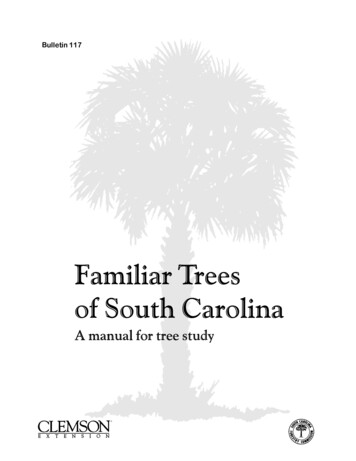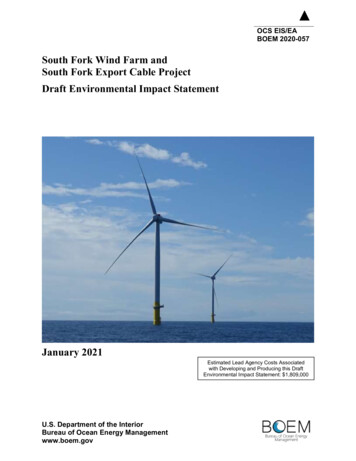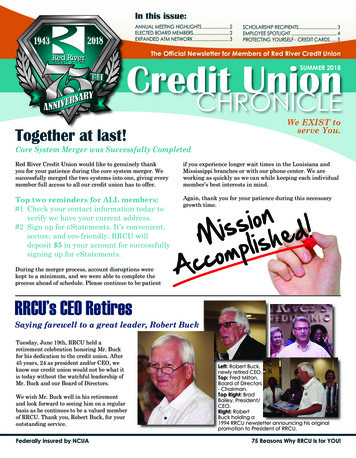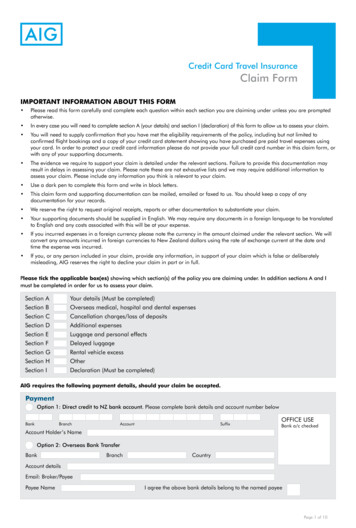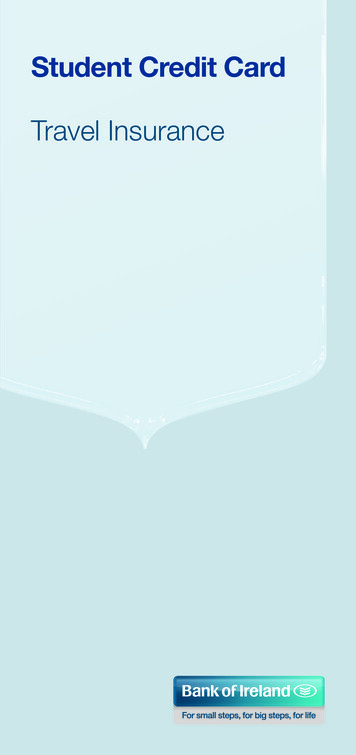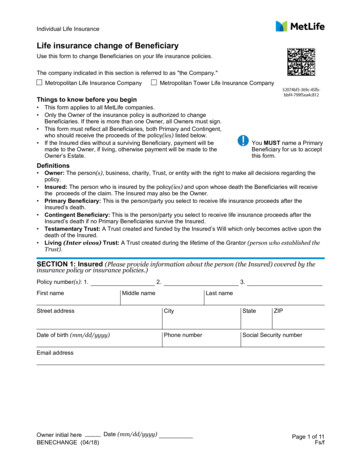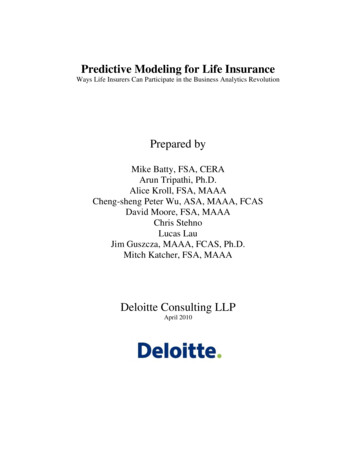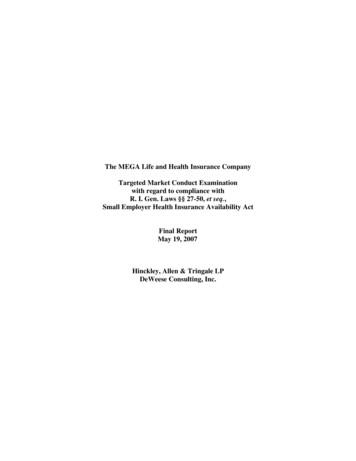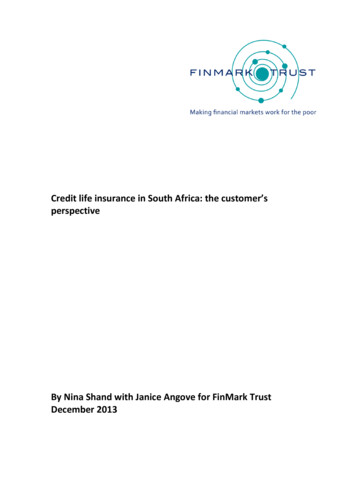
Transcription
Credit life insurance in South Africa: the customer’sperspectiveBy Nina Shand with Janice Angove for FinMark TrustDecember 2013
Table of ContentsList of Abbreviations and Acronyms . iii1. Introduction .42. What is credit life insurance? .52.1. Features .53.2.2.Models .62.3.Value proposition .7The regulatory environment for credit life insurance in South Africa .93.1. Regulatory bodies .93.2.4.5.South African market for credit and credit life insurance . 124.1. Overview. 124.1.1.Size and composition . 124.1.2.Products and providers . 13Does the credit life insurance market work for consumers? . 155.1. Supply-side perspective. 155.1.1.Interviews with industry bodies and credit life insurance providers . 155.1.2.Interviews with ombuds . 165.2.Methodology . 175.2.2.Key findings. 19Data perspective. 285.3.1.Cost of credit life insurance . 285.3.2.Claims and expense ratios . 30Conclusion . 32Appendix A: International examples . 347.1. Australia . 347.2.8.Demand-side perspective . 175.2.1.5.3.6.7.Main regulatory provisions.9United Kingdom . 36Appendix B: Overview of legislation relevant to credit life insurance in South Africa. 388.1. National Credit Act, 34 of 2005 . 388.1.1.9.NCA provisions. 388.2.Insurance legislation . 408.3.Industry guidelines . 418.4.Planned legislation . 42Appendix C: Overview of main credit providers in the credit life space . 439.1. Furniture retailers. 439.2.10.11.Unsecured/personal loan providers . 469.2.1.African Bank. 479.2.2.Capitec Bank . 479.2.3.Other micro lenders. 48Appendix D: Mystery shopping and consumer interview methodology . 49Appendix E: Issues raised by credit life insurance providers . 52i
11.1.11.1.1.Regulation. 5211.1.2.The marketplace . 5211.1.3.Credit bureaux . 5311.2.12.13.Issues raised by providers and industry bodies. 52Issues raised by the two ombuds . 53Appendix F: Snapshots of quotations . 54References .2List of tablesTable 1. Overview of credit life insurance models .7Table 2: Credit life insurance complaints categorised by nature of complaint (2012) . 17Table 3: Credit check and affordability assessment . 20Table 4: Comparison between 3 major furniture retailers (see Appendix F for originals). 22Table 5: Comparison between 3 microloan providers for loans to the value of R2 000. 23Table 6: Credit life specific questions . 24Table 7: Current premium rates relative to proposed maximum rates. . 29Table 8: Claims and expense experience for credit life business for South African insurers . 30Table 9: Product disclosure recommendations from ASIC review of Australian CCI market . 35Table 10: Loan comparison for 5 providers . 48Table 11: Comparison of 5 credit life policies . 48List of boxesBox 1: Trends in uptake of credit and insurance . 13Box 2: Retail furniture credit pricing . 14ii
List of Abbreviations and AcronymsABILAfrican Bank Investments LimitedAECAdverse Effect on CompetitionAEDOAuthenticate Early Debit OrderASICAustralian Securities and Investment CommissionASISAAssociation of Saving and Investment South AfricaCBACredit Bureau ActCCIConsumer Credit InsuranceCPACredit Protection ActFAISFinancial Advisory and Intermediary Services ActFSBFinancial Services BoardJDGJD GroupLTIALong Term Insurance ActMFRCMicrofinance Regulatory CouncilNCANational Credit Act, 2005NCRNational Credit RegulatorNLRNational Loans RegisterOFTOffice of Fair TradingPPIPayment Protection InsuranceSAIASouth African Insurance AssociationSAMSolvency Assessment and Management ActStanGenStandard General Insurance Company LimitedSTIAShort Term Insurance Actiii
1.Introduction1Credit life insurance is one of the most widely available insurance products to low-incomeconsumers world-wide and is often a low-income consumer’s first encounter with insurance.Therefore the question of whether consumers are getting a fair deal when they purchase it iscentral to the inclusive insurance debate. This paper analyses the question through the lensof the low-income consumer in South Africa.The research in this paper follows an independent panel of enquiry, known as the Nienaberpanel, to “identify and eradicate undesirable practices prevalent in the consumer creditinsurance market impacting negatively on consumers”2. The panel report, released in 2008,found that while consumer credit insurance (CCI) fulfilled a definite insurance need, it is inthe first instance designed to serve the interests of the credit provider and that there weredeficiencies in the system that could be exploited by unscrupulous providers. It found thatCCI has a bad name – and not only in SA – and that this perception may relate to variousfactors, including a lack of proper disclosure. However, the panel cautioned that CCI comesin a variety of forms and is issued by a variety of insurers, making generalisation difficult.In 2011, government formed a Consumer Credit Insurance Task Team, jointly led by NationalTreasury and the Financial Services Board, to investigate the state of the consumer creditinsurance industry in South Africa. The current study complements the work of the TaskTeam in that it offers a demand-side perspective on how consumers experience thepurchase of credit life insurance, particularly in the low income space, as per FinMark Trust’sfocus (using LSM 1-73 as a proxy indicator for the low-income market).Note that this study focuses specifically on credit life insurance – insurance taken out by aconsumer to cover a debt they have incurred in the event of death, disability orretrenchment, often at the insistence of the credit provider as a form of collateral security.The Task Team, as did the Nienaber panel, focuses on consumer credit insurance, a broaderterm referring to both credit life insurance and asset protection insurance on goods boughton credit.The main methodology for the study is a mystery shopping exercise focused on a broadrange of furniture retail and microfinance outlets operating in the LSM 1-7 space.4 Inaddition, in-depth interviews were conducted with low income consumers who had enteredinto a credit agreement or taken out a micro-loan. The questions focussed on the wholeprocess of purchasing credit life insurance, beginning with the application for credit, in anattempt to see at what point in the process and in what manner credit life is being sold. In1At the time of publication the exchange rate between the South African Rand and the United States Dollar and Great BritishPound was ZAR 10.36/USD and ZAR17.02/GBP respectively. USD and GBP equivalents shown throughout this document wereconverted at this rate.2A Report by the Panel of Enquiry on Consumer Credit Insurance in South Africa, p1.3“LSM (Living Standards Measure) refers to the most widely used marketing research tool in Southern Africa, cutting acrossrace, gender and other traditional marketing segments to focus instead on how one lives, taking into account one’s generalliving standards and access to amenities. It divides the population into 10 LSM groups, 10 (highest) to 1 (lowest). Lower-incomeproducts would generally be targeted at categories 2 through 6 (as those in category 1 would have no disposable income),although 7 is also relevant in the context of promoting financial inclusion.4Credit life insurance sold through these outlets was the focus of this study because these were the most likely to target thelower-income segment. Exploring the retail clothing sector could be considered for a follow-up study.
effect, the purpose was to establish the way in which sales staff on the ground is complyingwith legislation and how this is impacting on the consumer experience of credit lifeinsurance.The rest of this paper is structured as follows: Section 2 provides an overview of credit life insurance models and the value propositionthereof. Section 3 outlines the regulatory environment for credit life insurance in South Africa, Section 4 provides an overview of the South African credit life insurance market. Section 5 outlines the findings of the study as emerged from the mystery shoppingexercise and consumer interviews. In addition, data analysis is conducted to highlighttrends in claims and expense ratios. The report concludes with emerging issues in Section 6.2.What is credit life insurance?2.1.FeaturesAccording to the National Credit Act (NCA): “’credit life insurance’ includes cover payable inthe event of a consumer’s death, disability, terminal illness, unemployment, or otherinsurable risk that is likely to impair the consumer’s ability to earn an income or meet theobligations under a credit agreement.”5 A credit provider is entitled to require a consumer tomaintain credit life insurance during the time of the agreement so that the loan will be paidshould something happen to the customer. The pay-out decreases in correlation to therepayment making it a decreasing sum assured product. It is designed to protect and providea measure of security for both the insured and the credit provider. It also provides anadditional source of income for the lender from the insurance sale.Depending on how the product is structured, it can consist purely of a life insurancecomponent or be structured as a “hybrid” product with life and general insurancecomponents.The life insurance component is typically structured as follows: Policies will pay a lump sum equal to the value of the outstanding debt in terms of acredit agreement in the event of the death of the assured life or their permanentdisability. Policies also typically offer a benefit covering either a proportion of the outstandingdebt, or a benefit that covers a proportion of your monthly instalment (up to 100%) for aspecified period of time (sometimes as little as three months). Pay-outs are made in theevent of the insured becoming temporarily disabled, retrenchment occurring, is placed5http://www.ncr.org.za/pdfs/NATIONAL CREDIT ACT.pdf p19
on short time that leads to a 20% reduction or more on the monthly basic income, or forcompulsory unpaid leave. Credit life insurance can also include dread disease cover where the consumer is coveredfor an amount equal to the death benefit if they are diagnosed with a dread disease suchas renal failure, paraplegia, heart attacks or loss of speech, amongst others.Typical terms and conditions that apply include: Retrenchment benefits are not paid if a person is self-employed or is retrenched within30 days of the commencement of the insurance cover (in some cases, waiting periodsare up to 3 months). In cases where the cover is towards monthly credit instalments, such instalments arepaid to the credit provider for a maximum of 12 months (although some insurers pay thefull amount owing by the assured). Credit life insurance is often not underwritten at the point of sale. In other words, theinsurer does not ask any health specific questions at the application stage. Pre-existing conditions are limited to 24 months preceding the policy inception andthese conditions are only excluded for 12 months post policy inception (as per the ASISAGuidelines)6. Some insurers specify that their liability does not extend beyond a person’s 65thbirthday.Sometimes credit life insurance is combined with asset protection cover which typicallyprovides cover for accidental damage or destruction of goods, fire or theft from thepremises, as well as riot cover. In terms of the NCA, credit providers may insist on bothcredit life insurance as well as product protection insurance. Product protection insuranceclaims must be submitted within 30 days if the asset is stolen or destroyed or damaged. Theinsured is then paid out for the loss and is relieved of the liability of continuing paying for anasset which they no longer have access to.72.2.ModelsCredit life insurance can be provided in one of four ways:ModelDescriptionCredit lifeinsurance offeredby the creditproviderThis is the most common arrangement. The insurer is the principal and thecredit provider/retailer is the agent. The credit life insurance is sold byintermediaries for commission in conjunction with the credit transaction withthe intermediary often being the credit provider. This is the model most of thefurniture retailers use with regards to selling credit life insurance. In the past,furniture retailers would enter into agreements with conventional insurancecompanies whereby the retailers would market and administer insurance67Association for Saving and Investment (ASISA) Credit Life Insurance Guidelines effective 01-03-2011Panel of Enquiry into credit life insurance
products on behalf of the insurer concerned in return for a commission.Following a trend towards integration of the value chain, the major retailersnow own their own insurance subsidiaries which provide the insuranceproducts they need to secure their credit sales, such as credit life insurance andproduct insurance They also often offer additional insurance such as funeralcover which is not related to the credit sale but is a voluntary add-on.8Cell captivesCell captives are a South African innovation . Under a cell captive arrangement,an entity such as a credit provider buys a cell in a cell captive insurer (a speciallylicenced long-term or short-term insurer) in the form of a class of shares. Thisallows the cell owner to on-sell insurance to its client base without setting upan insurance company of its own or becoming a commissioned intermediary.Instead of paying premiums to an insurer, the cell captive can keep theunderwriting profits and build capital in their cells. In effect, the cell owner thus“rents” or “buys” part of the cell captive insurer’s licence, with the fullinsurance compliance burden resting on the cell captive insurer.Credit provider aspolicyholderUnder this model, the credit provider’s whole book is insured by one insurer,9with the credit provider, rather than individual borrowers, as policyholder.Thus no insurance is sold to borrowers. Instead, the credit provider pays thepremium to the insurer and is the beneficiary of any claims payments.Self-insuranceThis covers credit for which there is no insurance offered and the creditprovider carries the risk of default internally, implicitly pricing for it in theinterest rate.Table 1. Overview of credit life insurance models2.3.Value propositionCredit life insurance protects both the credit provider and the consumer: 8It protects the credit provider against default on repayments relating to the riskscovered. In addition, it provides credit providers with the opportunity to earn additionalfee income (commission and administration fees), allows it to avoid the need to attemptclaim payment from a deceased borrower’s estate, which could lead to negative publicrelations, and allows the lender to offer a broader set of financial products.10 Thesebenefits have precipitated the expansion of credit life insurance and the establishmentof closer links between credit providers and insurers offering this type of insurance.Cell captives now constitute more than R10 billion of the country’s insurance market in terms of premiums written,accounting for one sixth of all short-term insurance written. Guardrisk has an estimated 56% of the cell captive market shareand have a cell captive arrangement (for example) with Thuthukani Financial Services and the Elite omes-publication-of-discussion-paper-on-cell-cap
maintain credit life insurance during the time of the agreement so that the loan will be paid should something happen to the customer. The pay-out decreases in correlation to the repayment making it a decreasing sum assured product. It is designed to protect and provide a measure of s
